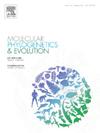Historical biogeography of the Mugil cephalus species complex and its rapid global colonization
IF 3.6
1区 生物学
Q2 BIOCHEMISTRY & MOLECULAR BIOLOGY
引用次数: 0
Abstract
Our understanding of speciation processes in marine environments remains very limited and the role of different reproductive barriers are still debated. While physical barriers were considered important drivers causing reproductive isolation, recent studies highlight the importance of climatic and hydrological changes creating unsuitable habitat conditions as factors promoting population isolation. Although speciation in marine fishes has been investigated from different perspectives, these studies often have a limited geographical extant. Therefore, data on speciation within widely distributed species are largely lacking. Species complexes offer valuable opportunities to study the initial stages of speciation. Herein we study speciation within the Mugil cephalus species complex (MCSC) which presents a unique opportunity due to its circumglobal distribution.
We used a whole-genome shotgun analysis approach to identify SNPs among the 16 species within the MCSC. We inferred the phylogenetic relationships within the species complex followed by a time-calibration analysis. Subsequently, we estimated the ancestral ranges within the species complex to explore their biogeographical history.
Herein, we present a fully resolved and well-supported phylogeny of the MCSC. Its origin is dated at around 3.79 Ma after which two main clades emerged: one comprising all West Atlantic and East Pacific species and the other all East Atlantic and Indo-Pacific species. Rapid dispersal following an initial founder colonization from the West to the East Atlantic led to the population of all major realms worldwide in less than 2 Myr. Physical and climatic barriers heavily impacted the ancestral distribution ranges within the MCSC and triggered the onset of speciation.

Mugil cephalus物种复群的历史生物地理学及其快速的全球殖民化。
我们对海洋环境中物种形成过程的理解仍然非常有限,不同繁殖障碍的作用仍在争论中。虽然物理障碍被认为是造成生殖隔离的重要驱动因素,但最近的研究强调,造成不适宜生境条件的气候和水文变化是促进种群隔离的重要因素。虽然海洋鱼类的物种形成已经从不同的角度进行了调查,但这些研究往往具有有限的地理存在。因此,在广泛分布的物种中,物种形成的数据在很大程度上是缺乏的。物种复合体为研究物种形成的初始阶段提供了宝贵的机会。在这里,我们研究了Mugil cephalus物种复合体(MCSC)内的物种形成,由于其全球分布,这是一个独特的机会。我们使用全基因组霰弹枪分析方法来鉴定MCSC内16个物种的snp。我们推断物种复合体内的系统发育关系,然后进行时间校准分析。随后,我们估计了物种复合体内的祖先范围,以探索其生物地理历史。在此,我们提出了一个完全解决和良好支持的MCSC系统发育。它的起源大约在3.79 Ma,之后出现了两个主要的分支:一个包括所有西大西洋和东太平洋物种,另一个包括所有东大西洋和印度太平洋物种。随着最初的创始人殖民从西大西洋到东大西洋的迅速扩散,在不到200万年的时间里,世界上所有主要领域的人口都增加了。自然和气候障碍严重影响了MCSC内的祖先分布范围,并引发了物种形成的开始。
本文章由计算机程序翻译,如有差异,请以英文原文为准。
求助全文
约1分钟内获得全文
求助全文
来源期刊
CiteScore
7.50
自引率
7.30%
发文量
249
审稿时长
7.5 months
期刊介绍:
Molecular Phylogenetics and Evolution is dedicated to bringing Darwin''s dream within grasp - to "have fairly true genealogical trees of each great kingdom of Nature." The journal provides a forum for molecular studies that advance our understanding of phylogeny and evolution, further the development of phylogenetically more accurate taxonomic classifications, and ultimately bring a unified classification for all the ramifying lines of life. Phylogeographic studies will be considered for publication if they offer EXCEPTIONAL theoretical or empirical advances.

 求助内容:
求助内容: 应助结果提醒方式:
应助结果提醒方式:


